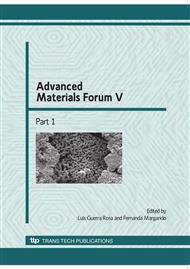p.60
p.68
p.76
p.82
p.91
p.98
p.104
p.111
p.119
Impedance Spectroscopy Evolution upon Sintering of Alumina Bodies Containing Al-Rich Anodizing Sludge
Abstract:
Al-rich sludge produced from industrial anodising and surface treatment processes had been tested in the fabrication of alumina-based materials, by using plastic extrusion as shaping technique. Long rods were produced using a vacuum screw extruder, by a careful control of all relevant processing parameters. Then, thick discs were obtained by cutting dried selected rods, to be tested as probes for sintering-dependent electrical properties. The sintering process was followed by common dilatometric/thermal analyses and results were interrelated with the evolution of electrical conductivity, estimated by impedance spectroscopy technique (IS). Results show that sintering-dependent morphological evolution up to 1300°C strongly affects the electrical behaviour of samples, and as a consequence IS seems to be a useful method to follow the firing process.
Info:
Periodical:
Pages:
91-97
Citation:
Online since:
January 2010
Authors:
Price:
Сopyright:
© 2010 Trans Tech Publications Ltd. All Rights Reserved
Share:
Citation:


